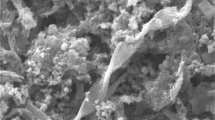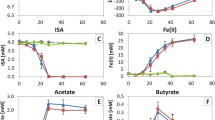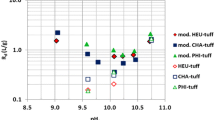Abstract
The aqueous-phase partitioning of 59Fe, 147Pm, 234Th and 241Am by complexing compounds from subsurface bacteria has previously been studied in the presence of quartz sand. In this study the aqueous-phase partitioning of pico-to submicromolar amounts of 59Fe, 147Pm, 234Th and 241Am was analyzed in the presence of TiO2 and exudates from three species of subsurface bacteria: Pseudomonas fluorescens, Pseudomonas stutzeri, and Shewanella putrefaciens. All were grown under aerobic conditions and P. stutzeri and S. putrefaciens were grown under anaerobic conditions as well. The supernatants of the aerobic and anaerobic cultures were collected and radionuclide was added. TiO2, with BET surface area of 49.9 m2·g−1, was added to the supernatant radionuclide mix, and the pH was adjusted to approximately 8. After incubation, the amount of radionuclide in the liquid phase of the samples and controls was analyzed using scintillation method. Two types of values were calculated: solution% = the activity maintained in solution relative to the total activity, and Q-values = the quotient between the activity in samples and the activity in controls. Aerobic supernatants had solution% values between 89% and 100% for 59Fe and between 18 and 43% for 234Th. The solution% values for 241Am and 147Pm were less than 2% overall, but the Q-values were between 34 and 115 times more 241Am in bacterial supernatants than in controls. The corresponding values for 147Pm ranged from 6 to 20 times more than in the control. The solution% values for all elements in the presence of anaerobic supernatants were below 2%, but the Q-values clustered around 7 for 59Fe and ranging from 2 to 29 for 234Th, indicated that anaerobic supernatants partitioned these elements to the aqueous phase. Both aerobic and anaerobic supernatants tested positive for complexing compounds when analyzed, using the Chrome Azurol S assay. Complexation with excreted organic ligands is most likely the reason for the higher amounts of metals in samples than in the controls. Hence, aerobically and anaerobically excreted organic ligands seem able to influence the mobility of radionuclides in aerobic and anaerobic environments contaminated with these compounds.
Similar content being viewed by others
References
K. Lieser, Radiochim. Acta, 70–71 (1995) 355.
V. Metz, B. Kienzler, W. Schuler, J. Contam. Hydrol., 61 (2003) 265.
K. Pedersen, Microbial Processes in the Disposal of High Level Radioactive Waste 500 m Underground in Fennoscandian Shield Rocks, Elsevier, Amsterdam, 2002, p. 279.
P. Toulhoat, Comp. Rend. Phys., 3 (2002) 975.
W. B. Whitman, D. C. Coleman, W. J. Wiebe, Proc. Natl. Acad. Sci., 95 (1998) 6578.
K. Pedersen, Diversity and Activity of Microorganisms in Deep Igneous Rock Aquifers of the Fennoscandian Shield, John Wiley & Sons Inc., New York, 2001, p. 97.
A. Johnsson, J. Arlinger, A. Ödegaard-Jensen, Y. Albinsson, K. Pedersen, Geomicrobiol. J., 23 (2006) 621.
A. M. Jakobsson, Measurement and Modelling Using Surface Complexation of Cation (II to IV) Sorption onto Mineral Oxides, Thesis, Chalmers University of Technology, Sweden, 1999.
W. Stumm, J. J. Morgan, Aquatic Chemistry: Chemical Equilibria and Rates in Natural Waters, 3rd ed., John Wiley & Sons Inc., New York, 1996, p. 1022.
M. Wazne, X. Meng, G. Korfiatis, C. Christodoulatos, J. Hazard. Mater., 136 (2006) 47.
A. Jakobsson, Y. Albinsson, Radiochim. Acta, 82 (1998) 257.
A.-M. Jakobsson, J. Colloid Interface Sci., 220 (1999) 367.
M. Olsson, A. Jakobsson, Y. Albinsson, J. Colloid Interface Sci., 266 (2003) 269.
A. Jakobsson, Y. Albinsson, R. Rundberg, Radiochim. Acta, 92 (2004) 683.
M. Pena, X. Meng, G. Korfiatis, C. Jing, Environ. Sci. Technol., 40 (2006) 1257.
M. Abe, P. Wang, R. Chitrakar, M. Tsuji, Analyst, 114 (1989) 435.
K. Pedersen, FEMS Microbiol. Rev., 20 (1997) 399.
Y. Stiglund, K. Aquilonius, Lake Tranebärssjön: Basic Characteristics and Evaluation of Restoration Options, RESTRAT-TD 13, Studsvik Eco & Safety AB, Nyköping, 1999.
R. E. Hungate, Meth. Microb., 111 (1966) 117.
J. Hobbie, R. Daley, S. Jasper, Appl. Environ. Microbiol., 33 (1977) 1225.
S. Payne, Methods Enzymol., 235 (1994) 329.
B. Schwyn, J. Neilands, Anal. Biochem., 160 (1987) 47.
Y. Albinsson, C. Ekberg, S. Holgersson, A. M. Jakobsson, A. Landgren, G. Skarnemark, Appl. Radiation Isotopes, 56 (2002) 681.
G. Choppin, J. Rydberg, J. Liljezin, Radiochemistry and Nuclear Chemistry, 2nd ed., Butterworth-Heinemann Ltd., Boston, 1995, p. 707.
B. Kalinowski, A. Johnsson, J. Arlinger, K. Pedersen, A. Ödegaard-Jensen, F. Edberg, Geomicrobiol. J., 23 (2006) 157.
J. J. Katz, G. T. Seaborg, L. R. Moriss, The Chemistry of the Actinide Elements, Chapman and Hall, New York, 1986, p. 1674.
L. A. Warren, E. A. Haack, Earth-Sci. Rev., 54 (2001) 261.
Manuscript submitted.
Author information
Authors and Affiliations
Corresponding author
Rights and permissions
About this article
Cite this article
Johnsson, A., Ödegaard-Jensen, A., Jakobsson, A.M. et al. Bioligand-mediated partitioning of radionuclides to the aqueous phase. J Radioanal Nucl Chem 277, 637–644 (2008). https://doi.org/10.1007/s10967-007-7067-5
Received:
Published:
Issue Date:
DOI: https://doi.org/10.1007/s10967-007-7067-5




